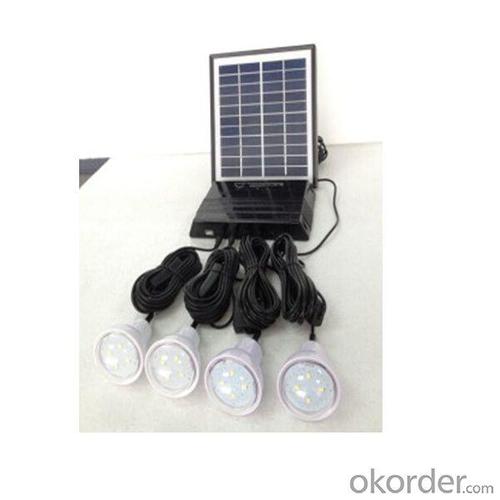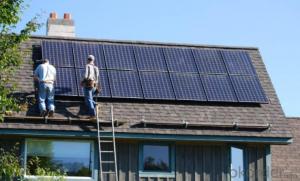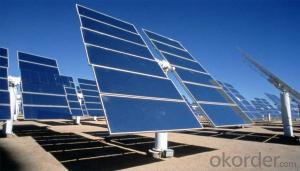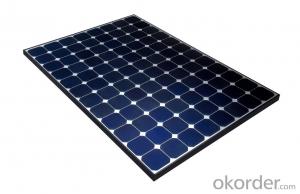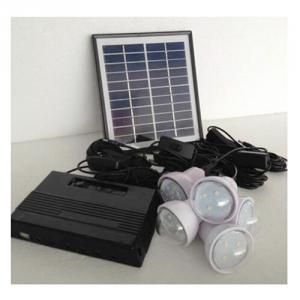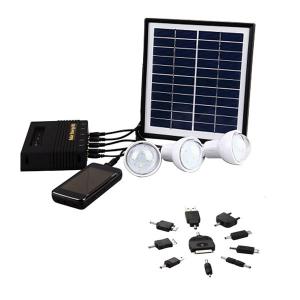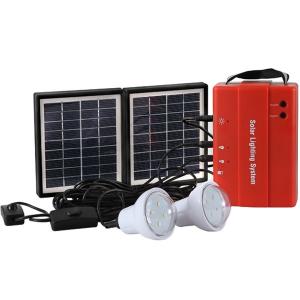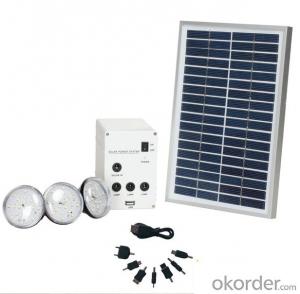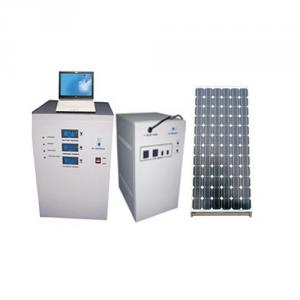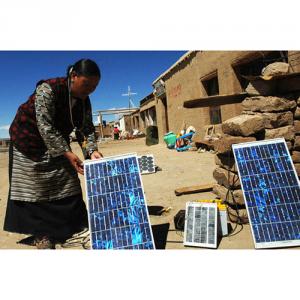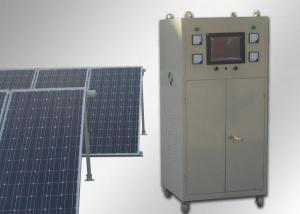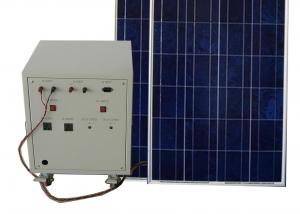Solar Energy Systems Whitehaven 4w 10w 20w 50w 80w 100w Solar Lighting System with Mobile Charge 4 LED Bulbs 4000mAh Li-ion Battery Black CE ROHS
- Loading Port:
- Shenzhen
- Payment Terms:
- TT/LC
- Min Order Qty:
- 100Sets set
- Supply Capability:
- 20000 SETS Per Month set/month
OKorder Service Pledge
OKorder Financial Service
You Might Also Like
This 4w solar lighting system with mobile charge for iphone 4w solar panel 4400mah lithium batetry black ce rohs is a portable solar energy system , solar energy generator can generate power for 4 LED bulbs, it can work 6 hours every day.

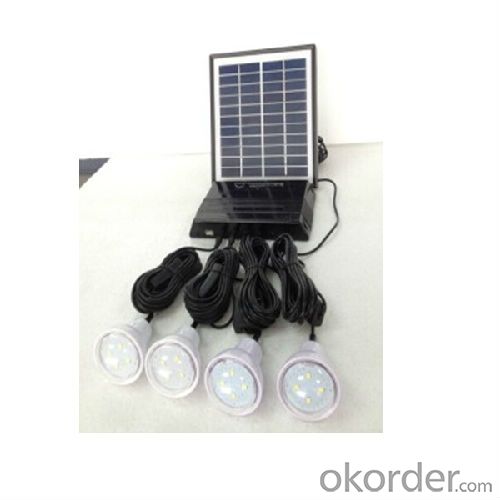
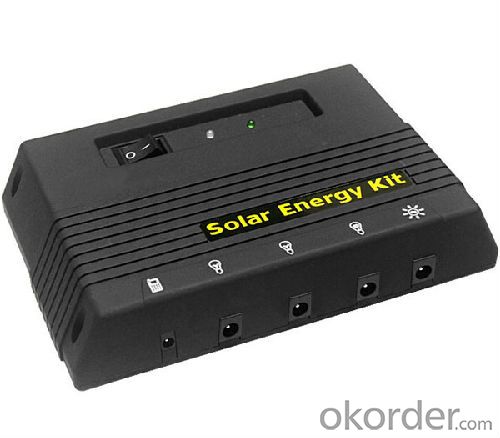
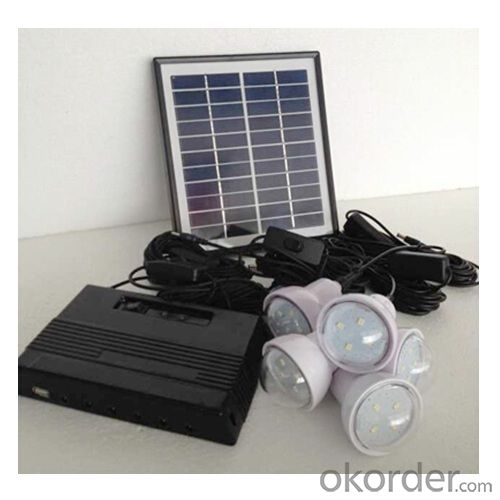
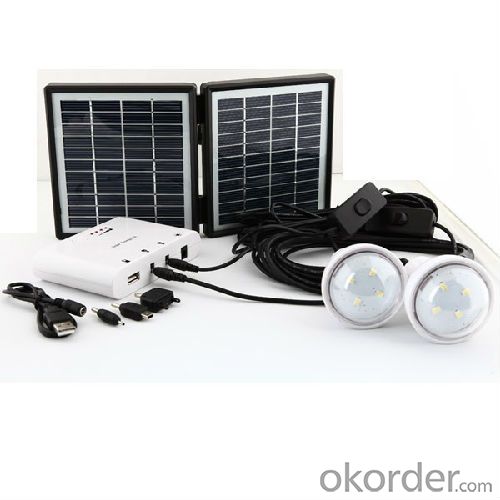
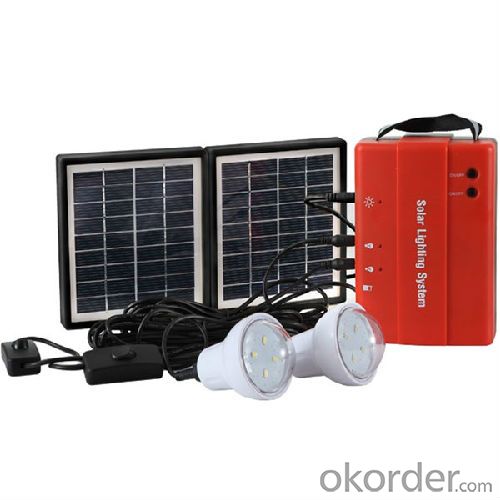
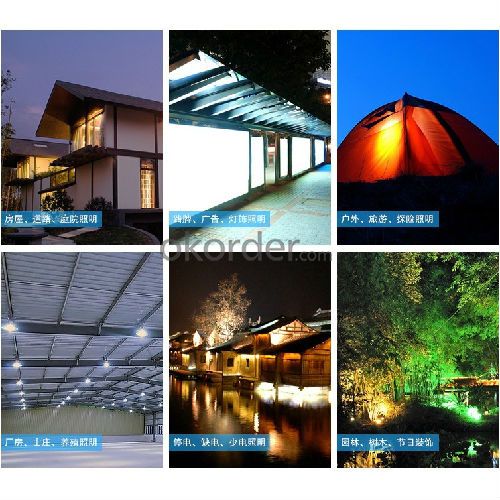
Feature
| battery: 7.4V 4400mAh Lithium battery |
| solar panel: 4W 11V Solar Panel with 5M cable |
| led bulbs: 0.9W LED bulb with 4pcs |
| LED bulb: each with 5M cable and switch on cable, IP54. |
| With LED charging indicator: yes |
| Mobile phone charging: USB port 5V 1000mA output, with 5-in-1 USB mobile charging cable (Nokia 6101,Sumsung G600, Micro USB, Mini USB,Iphone 4/4S) |
| Overcharge and overdischarge protection: yes |
| Rechargeable by AC charger: optional |
| Working hours on full battery: |
| 5 bulbs-6 hours |
| 4 bulbs-7.5 hours |
| 3 bulbs-10 hours |
| 2 bulbs-15 hours |
| 1 bulb-30 hours |
| Full charging time |
| By solar-16 hours (under direct sunshine) |
| By AC charger-about 11 hours |
Usage/Applications
Rural homes, campers, fishermen, outdoor campaigns or activities, etc. Remote area, mountainous area, desert area, grassland area,
Village, country area, Camping, outdoor activities, travel, Lighting at night.
Customized options
1. OEM/ODM available;
2. It's also available to customize your own solar lighting systems, solar lanterns, or any solar lighitng products by giving us solar lights picture / 3D draft / technical datas.
Packing & Delivery
Package:
1* solar panel
1* portable system box
4* LED bulbs with on/off button on cable
inner box size: 335*255*84mm
10pcs/carton
carton size:525*350*450mm
Delivery:
|
Shipping Service |
Estimated Delivery Time |
|
DHL |
2-8 business days |
|
FedEx |
3-8 business days |
|
TNT |
2-10 business days |
|
UPS |
1-7 business days |
|
EMS |
6-14 business days |
|
ePacket |
7-12 business days |
|
China Post Air Mail |
7-15 business days |
|
China Post SAL |
14-30 business days |
|
Air freight |
3-10 business days |
|
By Sea |
30-40 business days |
1. 3-5 business days for Sample Orders; 7-30 business days for Bulk Orders for Bulk Orders.
2. "Business days" means Monday-Friday, excluding holidays.
3. DHL and UPS cannot ship to military or P.O. boxes address
4. The Shipping Service above is for reference only, for any other questions, please feel free to contact us.
Factory
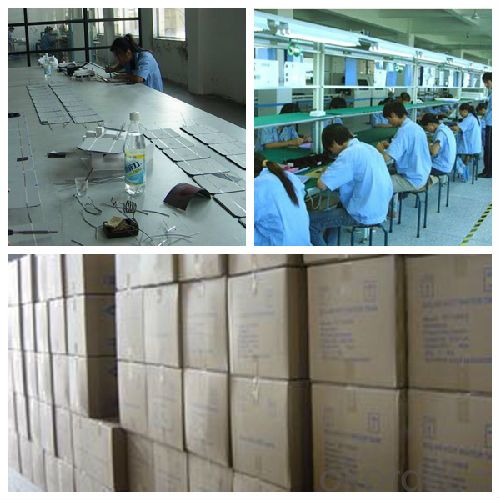
- Q: What are the components of a solar energy system?
- A solar energy system consists of several key components that work together to harness the power of the sun and convert it into usable electricity. The main components of a solar energy system include: 1. Solar Panels: These are the most recognizable element of a solar energy system. Solar panels, also known as photovoltaic (PV) panels, are made up of multiple solar cells that convert sunlight into direct current (DC) electricity. They are typically mounted on the roof or ground to capture sunlight. 2. Inverter: The DC electricity generated by the solar panels needs to be converted into alternating current (AC) electricity, which is the type of electricity used in homes and businesses. An inverter is responsible for this conversion process, ensuring that the electricity can be used by various appliances and devices. 3. Mounting System: Solar panels need to be securely mounted on rooftops or on the ground. The mounting system consists of racking or frames that hold the panels in place and allow for optimal sunlight exposure. The mounting system also ensures that the panels are installed at the correct angle and orientation to maximize energy production. 4. Electrical Wiring: Proper electrical wiring is crucial to connect the solar panels, inverter, and other components of the solar energy system. The wiring carries the electricity from the panels to the inverter, and then to the electrical panel of the building, where it can be distributed and used. 5. Batteries (Optional): In some solar energy systems, batteries are included to store excess electricity generated during the day for use during the night or during periods of low sunlight. These batteries store the excess energy and release it when needed, allowing for a more consistent and reliable power supply. 6. Monitoring System: Many solar energy systems come with a monitoring system that allows users to track the performance and energy production of their system. This can be done through a web-based platform or a smartphone app, providing real-time data on energy generation, consumption, and savings. 7. Grid Connection (Optional): Solar energy systems can be connected to the electrical grid, allowing excess electricity to be fed back into the grid when the system produces more energy than is being used. This is known as net metering, and it allows homeowners to earn credits or receive compensation for the excess energy they generate. Overall, a solar energy system is a complex and interconnected set of components that work together to harness the sun's energy and convert it into usable electricity for various applications. These components enable individuals and businesses to reduce their reliance on traditional fossil fuel-based energy sources and contribute to a cleaner and more sustainable future.
- Q: How do solar energy systems affect water usage?
- Solar energy systems have a minimal impact on water usage compared to traditional energy sources. Unlike fossil fuel power plants that rely heavily on water for cooling and steam generation, solar energy systems do not require water for their operation. This makes solar energy a more sustainable and eco-friendly option, as it reduces water consumption and helps conserve this vital resource.
- Q: Can solar energy systems be used in areas with high levels of dust or sandstorms?
- Solar energy systems can indeed be utilized in regions with significant amounts of dust or sandstorms. Although these natural occurrences can momentarily decrease the efficiency of solar panels by obstructing sunlight, there are various steps that can be taken to mitigate their impact. Firstly, it is crucial to regularly clean and maintain solar panels to eliminate accumulated dust and debris, ensuring the maximum absorption of sunlight. This can be achieved through manual cleaning or by utilizing automated cleaning systems that employ water or brushes to keep the panels pristine. Secondly, there are advanced panel designs and coatings available that minimize the adherence of dust particles and facilitate effortless cleaning. These technologies enable panels to self-clean or reduce the accumulation of dust, guaranteeing optimal performance even in dusty environments. Additionally, proper installation and positioning of solar panels play a significant role in minimizing the impact of dust or sandstorms. By tilting the panels at an appropriate angle and maintaining sufficient ground clearance, the accumulation of dust can be minimized. Furthermore, employing protective measures such as fences, windbreakers, or enclosures around the solar energy systems can shield the panels from strong winds and blowing sand during sandstorms. These measures effectively prevent physical damage to the panels and maintain their functionality. In conclusion, although dust or sandstorms may present temporary obstacles to solar energy systems, with proper maintenance, cleaning, panel design, positioning, and protective measures, solar energy can still be effectively harnessed in areas with high levels of dust or sandstorms.
- Q: Can solar energy systems be used in areas with frequent hurricanes?
- Yes, solar energy systems can be used in areas with frequent hurricanes. While it is true that hurricanes can cause damage to solar panels and other components of solar energy systems, there are measures that can be taken to mitigate these risks. Firstly, the design and installation of solar energy systems in hurricane-prone areas can be done to withstand high winds. This includes using stronger mounting systems, reinforced frames, and secure anchoring techniques. Additionally, the orientation and tilt angle of the panels can be optimized to minimize wind resistance. Furthermore, regular maintenance and inspections can help identify any potential issues or damage to the system before a hurricane hits. This allows for timely repairs or replacements, ensuring the system remains functional and safe during extreme weather events. In the event of a hurricane, it is important to have emergency procedures in place to secure the solar panels and other components. This can involve temporarily removing the panels and securing them indoors or utilizing protective covers to shield them from debris. Moreover, the use of microinverters or power optimizers in solar energy systems can enhance their resilience in hurricane-prone areas. These technologies allow each solar panel to operate independently, mitigating the impact of any damage to a single panel and preventing the entire system from shutting down. Lastly, solar energy systems can also contribute to the resilience of communities during and after hurricanes. With proper battery storage, solar systems can provide backup power during power outages, allowing essential services to continue operating and providing electricity for critical needs such as lighting, refrigeration, and medical equipment. Overall, while precautions need to be taken to ensure the durability and functionality of solar energy systems in hurricane-prone areas, they can be effectively used to harness clean and renewable energy even in the face of frequent hurricanes.
- Q: Can a solar energy system withstand extreme weather conditions?
- Yes, a solar energy system can withstand extreme weather conditions. Solar panels are designed to be durable and are built to withstand a range of weather conditions, including extreme heat, cold, wind, rain, and snow. They are made with tempered glass and are often tested to ensure they can withstand hailstorms or heavy snow loads. Additionally, solar panels are typically installed securely to withstand strong winds and are designed to be resistant to corrosion. Overall, while extreme weather conditions can have some impact on solar energy production, solar energy systems are built to withstand and continue operating effectively in a variety of weather conditions.
- Q: Can solar energy systems be used in areas with high levels of air humidity?
- Yes, solar energy systems can be used in areas with high levels of air humidity. While high humidity can affect the efficiency of some components, such as reducing the effectiveness of solar panels, it does not render solar energy systems completely unusable. In fact, solar energy systems are deployed and successfully function in many high-humidity regions around the world. Additionally, advancements in technology and design have improved the performance of solar panels in humid conditions. For instance, anti-reflective coatings on the panels can help prevent moisture buildup and ensure better performance. Overall, while humidity may slightly impact the efficiency of solar energy systems, it does not prevent their use in areas with high levels of air humidity.
- Q: How does the size of a solar energy system affect its installation cost?
- The size of a solar energy system directly affects its installation cost. Larger solar energy systems typically require more solar panels, inverters, and other equipment, which in turn increases the overall cost of installation. Additionally, larger systems often require more complex mounting systems and electrical wiring, which can further contribute to the installation cost. However, the cost per watt of a solar energy system generally decreases as the system size increases. This is because larger systems benefit from economies of scale, allowing for bulk purchasing of materials and reduced labor costs. As a result, the cost per watt decreases, making larger systems more cost-effective in terms of installation. Furthermore, the size of the solar energy system also impacts the amount of energy it can generate. Larger systems have a higher capacity and can produce more electricity, making them suitable for fulfilling higher energy demands. This can be advantageous for homeowners or businesses with larger energy consumption, as they can offset a greater portion of their electricity bills. It is important to note that the specific installation cost of a solar energy system depends on various factors such as location, equipment quality, labor costs, and available incentives. Therefore, while size is a significant factor, it is not the sole determinant of the installation cost.
- Q: Can a solar energy system be installed in an area with limited sunlight?
- Yes, a solar energy system can be installed in an area with limited sunlight. While solar panels are most effective in areas with abundant sunlight, they can still generate electricity even in areas with less sunlight. The efficiency of the system may be lower, but it can still provide a renewable energy source. Additionally, advancements in solar technology, such as the use of more efficient panels and energy storage solutions, can help optimize the system's performance in areas with limited sunlight.
- Q: Can solar energy systems be used for powering electric boat charging stations?
- Yes, solar energy systems can be used for powering electric boat charging stations. Solar panels can be installed on the charging station's roof or nearby to harness sunlight and convert it into electricity. This renewable energy source can then be used to charge electric boats, making the charging process eco-friendly and sustainable.
- Q: How do solar energy systems impact energy independence?
- Solar energy systems can greatly impact energy independence by reducing reliance on traditional energy sources such as fossil fuels. By harnessing the power of the sun, solar energy systems provide a clean and renewable source of electricity. This reduces the need to import energy from other countries, enhancing a nation's energy independence. Additionally, solar energy systems can be installed at individual homes and businesses, allowing individuals to generate their own electricity and become less dependent on the grid. Overall, solar energy systems play a crucial role in promoting energy independence and reducing the carbon footprint.
1. Manufacturer Overview
| Location | |
| Year Established | |
| Annual Output Value | |
| Main Markets | |
| Company Certifications |
2. Manufacturer Certificates
| a) Certification Name | |
| Range | |
| Reference | |
| Validity Period |
3. Manufacturer Capability
| a) Trade Capacity | |
| Nearest Port | |
| Export Percentage | |
| No.of Employees in Trade Department | |
| Language Spoken: | |
| b) Factory Information | |
| Factory Size: | |
| No. of Production Lines | |
| Contract Manufacturing | |
| Product Price Range | |
Send your message to us
Solar Energy Systems Whitehaven 4w 10w 20w 50w 80w 100w Solar Lighting System with Mobile Charge 4 LED Bulbs 4000mAh Li-ion Battery Black CE ROHS
- Loading Port:
- Shenzhen
- Payment Terms:
- TT/LC
- Min Order Qty:
- 100Sets set
- Supply Capability:
- 20000 SETS Per Month set/month
OKorder Service Pledge
OKorder Financial Service
Similar products
Hot products
Hot Searches
Related keywords




